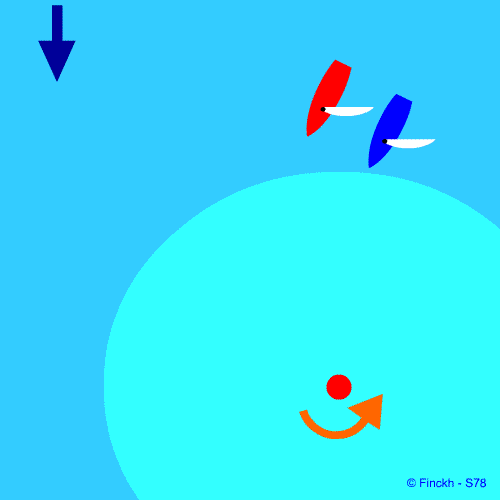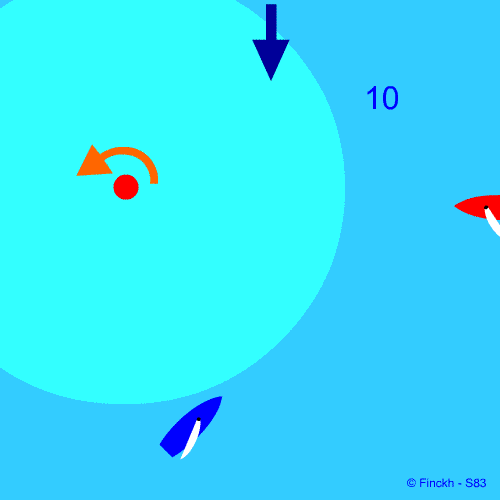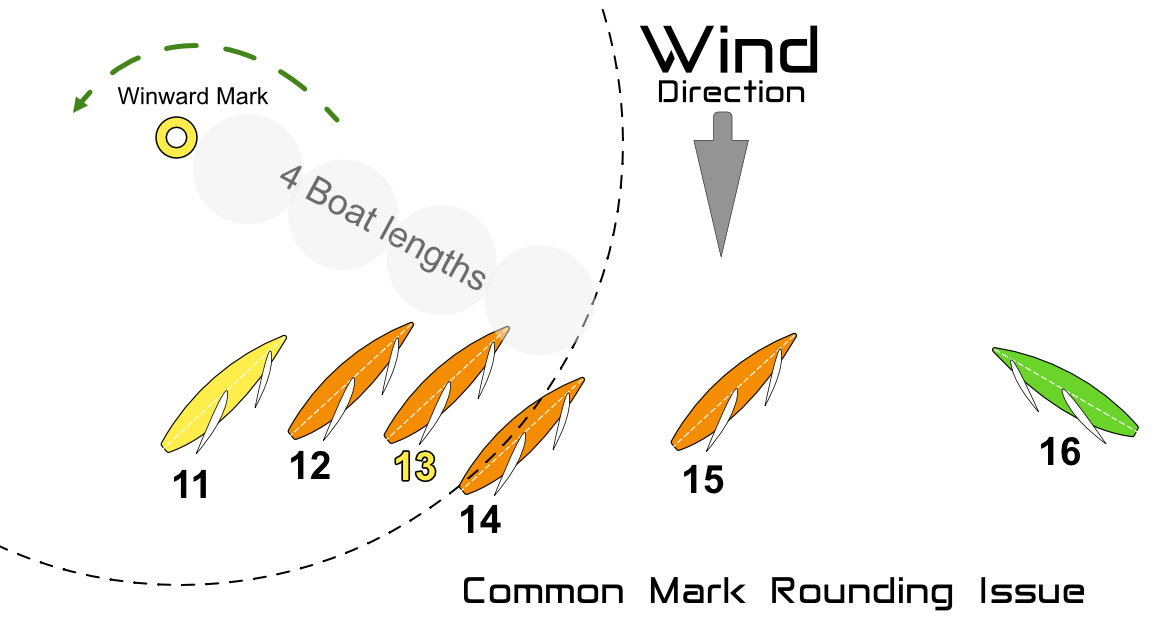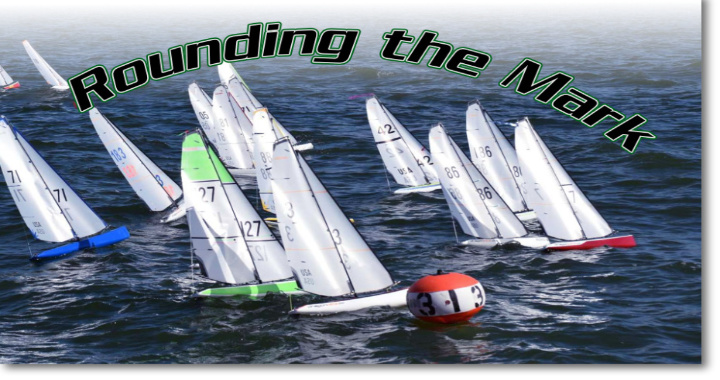
Which boat will be penalized in a valid protest?
Blue
Red
ANSWER:
Red will be penalized. Blue is inside right-of-way boat and Red must keep clear and give mark-room in accordance with rule 11 and rule 18.2(b). Blue is bound by rule 18.4 to sail no further from the mark than her proper until she gybes. Blue complies with these requirements. Red does not give mark-room and will be penalized for infringing rule 18.2(b). When Blue bears away hard for gybing and infringes rule 16, 10 or 11 she is exonerated by rule 43(b). See also World Sailing Case 75.
Rule 11 ON THE SAME TACK, OVERLAPPED
When boats are on the same tack and overlapped, a windward boat shall keep clear of a leeward boat.

Is the tack of Blue in the rules?
Yes
No
ANSWER:
Yes. Blue passes head to wind in the zone and rule 18.3 applies. Red has to change course after Blue has beard away to a close-hauled course but is not caused to sail above close-hauled. Therefore Blue does not break rule 13 or rule 18.3.
13 WHILE TACKING
After a boat passes head to wind, she shall keep clear of other boats until she is on a close-hauled course. During that time rules 10, 11 and 12 do not apply. If two boats are subject to this rule at the same time, the one on the other’s port side or the one astern shall keep clear.
Play the Rules Images are compliments of Uli and Wolfi Finckh

Common conditions at our upwind marks
With the shifty winds we have on our pond, it is common for many boats to approach the windward mark on port tack, whether or not they intended this from the start. This situation leads to many complications. The only starboard tack boat here, Sail No 16, has been hailing 'Starboard' for several seconds. While such a hail is not necessary to establish right of way (r.o.w.), it does reinforce his claim.
The next boat he will have to deal with, Sail No 15, responded quickly to 16's hail by calling out 'Room to Tack!!!' before this position was reached, as 15 saw 16 approaching and knew what was coming. Similarly boats 13 and 14 hailed for room to tack at an obstruction, a r.o.w. starboard tack boat. Yellow 11 refused to tack because he could not yet clear the mark, and he was not obliged by the clump of other port-tack boats to tack, until the starboard tack boat approached with r.o.w. and became an obstruction.
When a boat hails for room to tack at an obstruction, every boat that might interfere with that tack has to tack immediately, or, when the situation allows, yell back 'You tack!' and then stay clear of the obstructed boat that is tacking. Clearly here there is no choice; all the yellow/orange boats must tack. Orange 15 could not tack earlier because there was no room for him to tack and give time for the clump to hail to tack at an obstruction; he was pinned to his port tack. Similarly for boats 12, 13, and 14. A boat acquiring r.o.w. must allow time for the give-way boats to react. There is nothing in the rules requiring a skipper to anticipate a tack or gybe, except right at a mark during rounding, and not always then. ........... Courtesy of Mike Biggs


So in the situation as shown, Yellow 11 is at fault for not tacking immediately. Did he actually realize the situation? Perhaps not, although failure to understand the rules is not an excuse, but one might understand the rules and still not recognize the situation. And just as this situation tends to arise on our pond because the winds shift so frequently, a wind shift right after this sketch could disrupt everything.
It is possible to just look for ways to use the rules just to be unfriendly, but that is rare. It is not at all rare for sailors to gain, or retain, an advantage by not following the rules, thinking they really aren’t hurting anything. A boat who ‘barges’ in at a starting mark, forcing a r.o.w. boat to leeward, gets not only a faster start than he has a right to, he also gains free water to tack onto port when it is beneficial, which the former r.o.w. boat cannot do because he gave way to the barging boat.